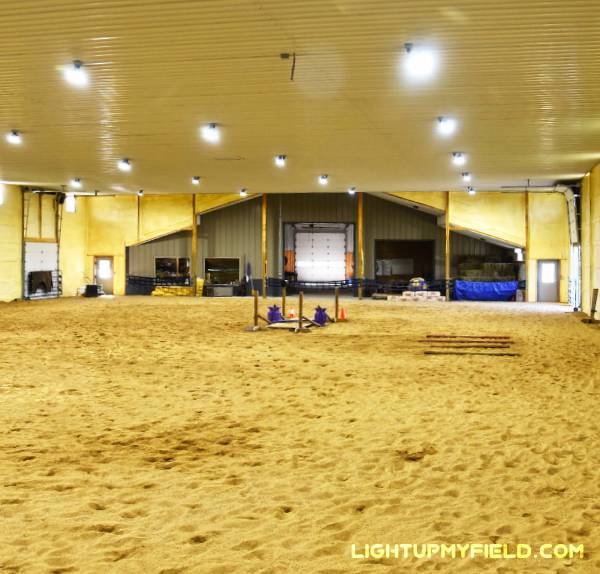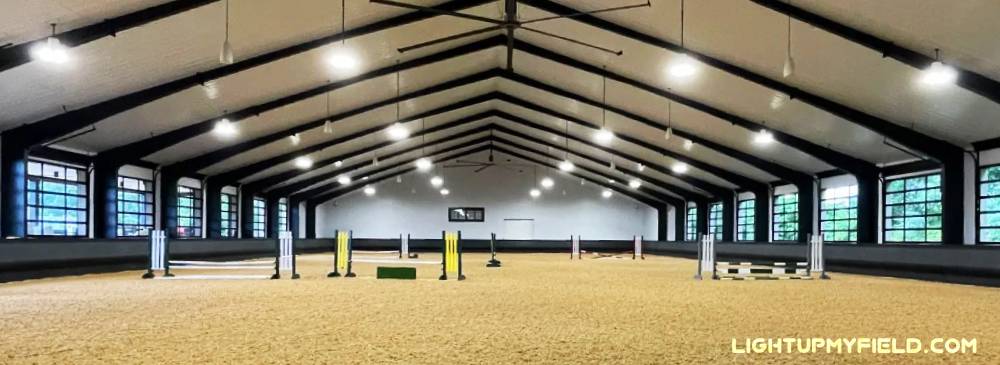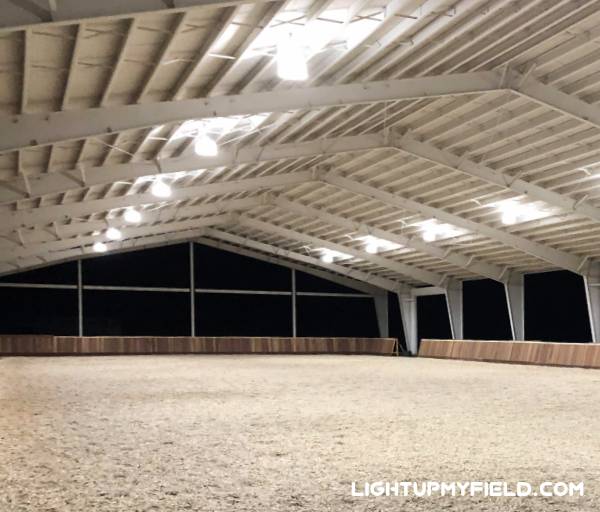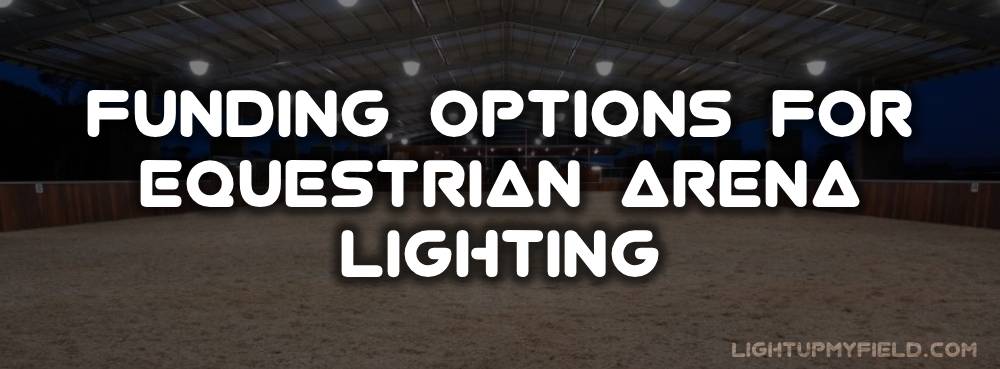Getting wonderful lighting for your riding arena can feel like a dream project—until you see the price tag. Between fixtures, poles, wiring, and installation, the total can easily run into tens of thousands of dollars. For many equestrian centers, riding schools, or community clubs, that’s a huge chunk of the budget. That’s where grants and other funding options step in. With the right planning, you might be able to cover a big part of your lighting costs without draining your own pocket.
But how do you know if you can apply, where to find these opportunities, and how to make your application stand out? Let’s walk through it.
Table of Contents
ToggleAm I Eligible to Receive Funding for Equestrian or General Riding Arena Lighting?
The first question that usually pops into people’s heads is, “Can I even apply for this kind of funding?” The short answer is often yes—but the long answer depends a bit on your setup, who owns the arena, and what type of grant you’re aiming for.
Some funding programs are written specifically with equestrian facilities in mind—think horse industry boards, agricultural associations, or equestrian sport development funds. Others are much broader, covering areas like community sports infrastructure, rural development, or renewable energy initiatives. If your lighting project can be framed to fit their goals, your chances start looking much better.
Non-Profit vs. Private Facilities

If your organization is a registered non-profit, you usually get a bit of a head start. Many grant providers—especially government-backed ones—love to see applications from groups that clearly benefit the public. Riding schools, pony clubs, and therapeutic riding programs are a perfect match because they offer measurable community impact.
But being a private facility doesn’t automatically push you out of the race. Some grants are geared toward small business growth, tourism development, or rural enterprise support. If your arena regularly hosts public clinics, youth programs, or competitive events, you may still be able to check the right boxes. In fact, there have been cases where privately owned arenas secured $5,000–$15,000 in regional funding simply by showing they were a hub for local activity.
How Size and Usage Play a Role
The scale of your arena can also make a difference. A smaller, lesson-focused arena often fits neatly into “community facility” funding streams, where budgets of $10,000–$50,000 are common. Larger venues—especially those that draw in riders from other towns or states—might be better suited for “regional sporting event” or “tourism development” grants. These can sometimes exceed $100,000 in available funds, but the competition for them is usually much tougher.
Another angle is safety and accessibility. If your proposal clearly shows that upgraded lighting will prevent accidents, improve visibility for older riders, or make evening use safer for youth programs, that’s a strong selling point. Some community safety grants specifically list lighting improvements as an eligible expense.
Energy Efficiency as a Ticket In
Here’s where the lighting tech itself can help your case. If you’re planning to install LED fixtures that cut energy use by 50–70% compared to traditional halogen lamps, or if you’re adding solar-powered light poles, your project may qualify for environmental or sustainability-focused grants. These often come from completely different departments—like environmental agencies or energy boards—but they can still cover a big chunk of your costs.
In some regions, upgrading to LED can also make you eligible for utility rebate programs, which can knock anywhere from $50 to $150 off per fixture. If your arena needs 20 lights, that’s potentially $1,000–$3,000 in extra savings before you even tap into the main grant.
What to Look For in Your Project Fit
If your lighting upgrade can check at least one or two of these boxes, you’ve got a real shot: it serves the community in some way, it improves safety and accessibility, it reduces environmental impact, or it supports youth, rural development, or sports growth. The trick is to phrase your application so those benefits shine through—sometimes literally.
Where Can I Apply for Funding?

Tracking down grants for arena lighting is a bit like looking for a needle in a haystack—you won’t always find them by typing “arena lighting grants” into Google and calling it a day. The best opportunities are often tucked away under broader funding categories. That means you’ll want to think beyond just “horse arena” and explore programs for community infrastructure, sports development, rural growth, or environmental upgrades.
It’s worth remembering that the funding doesn’t always have to come from horse-related sources. Government bodies, sports organizations, charities, and even private companies have been known to support projects like this—especially if you can show how your lighting upgrade benefits more than just your own riding schedule.
Government Funding
Local councils, regional development agencies, and national sports departments are often the first place to look. They frequently run community facility improvement programs that cover lighting as part of safety upgrades, rural sports access, or tourism growth initiatives. In many cases, the numbers can be quite attractive—regional grants often range from $5,000 to $50,000 depending on the scope of your project.
For example, a small equestrian club that upgraded its arena lighting in 2024 received $22,000 through a rural development fund by demonstrating that the improvements would allow more evening events and attract riders from neighboring towns. Government-backed sports infrastructure programs also like to see projects that increase participation, so if your lighting allows year-round training or winter competitions, that’s a strong angle to push.
Sports and Equestrian Organizations
Your national equestrian federation or local sports council might have smaller-scale grants for arenas that host competitions, youth programs, or official training events. While these grants tend to be on the lower side—anywhere from $2,000 to $10,000—they can still make a dent in your costs, especially if you stack them with other funding sources.
Even smaller bodies like pony clubs, riding associations, and agricultural show societies can be worth approaching. They often have “micro-grants” in the $500–$2,000 range for local improvements, and although that won’t cover the whole project, it can help you cover specific expenses like LED upgrades or a new control system.
Environmental and Sustainability Programs
If your project leans into solar-powered lighting or energy-efficient LEDs, the funding opportunities start to multiply. Renewable energy incentive programs—sometimes run through environmental agencies or utility companies—can cover 30–50% of your lighting upgrade cost.
In rural or off-grid areas, these incentives can be even more generous, with some schemes offering up to $1,000 per solar pole or rebates of $100–$150 per LED fixture. Beyond the financial benefit, highlighting sustainability in your application can make it stand out in a crowded funding pool, especially as more organizations are looking to support projects that cut long-term energy use.
Private Foundations and Companies
Big-name corporations, particularly those in agriculture, construction, or energy, sometimes have community grant programs tucked away on their websites. These grants are often smaller—anywhere from $500 to $5,000—but they can be easier to apply for and often have quicker approval timelines than government programs.
For instance, some agricultural supply companies run “community improvement” rounds twice a year, giving small grants to projects that benefit rural life. If your arena is used for county fairs, agricultural shows, or riding club events, you may be able to tie your project into their mission and secure a fast win.
| Funding Source | Typical Grant Amount | Additional Details / Percentages |
|---|---|---|
| Government (local councils, regional agencies, national sports departments) | $5,000–$50,000 | Example: $22,000 awarded in 2024 for rural arena lighting upgrade |
| Sports & Equestrian Organizations | $2,000–$10,000 | Smaller bodies: $500–$2,000 micro-grants |
| Environmental & Sustainability Programs | Covers 30–50% of project cost | Up to $1,000 per solar pole; $100–$150 per LED fixture |
| Private Foundations & Companies | $500–$5,000 | Often quicker approval, sometimes semi-annual cycles |

Available Horse Arena Lighting Grants in 2025 and 2026
Maryland Horse Industry Board Grants (2026)
If you’re based in Maryland and your arena lighting could use a serious upgrade, the Maryland Horse Industry Board (MHIB) grant cycle for 2026 is worth keeping on your radar. These grants top out at $2,000, with most awards landing closer to the $1,000 mark. That might not sound like it’ll light up a whole stadium, but it’s the kind of funding that can cover a key part of your project—whether that’s upgrading old halogen fixtures to LEDs or adding lighting controls for energy savings.
In the 2025 round, MHIB funded 38 projects across the state, putting nearly $30,000 back into the local horse community. Past winners have included riding clubs, nonprofit stables, therapeutic riding centers, and even schools with equestrian programs. The application window opens August 1, 2025, with results announced by January 2026 and funding distributed shortly after. If your project can show that it will strengthen the local horse scene—say, by making it possible to hold evening lessons, winter schooling shows, or safety-focused upgrades—you’ve got a good shot.
Grants via County Fair Associations
If your arena is part of a fairground, show venue, or community event space, county fair associations can be a hidden goldmine for lighting upgrades. While these aren’t always called “arena lighting grants,” funding for infrastructure improvements often covers electrical work, fixture replacements, and even new pole installations.
Take Illinois, for example—some county fairs have received funding to replace outdated lighting in livestock barns and outdoor show arenas, with awards ranging from $3,000 to $15,000. In Minnesota, arenas used for horse shows have received grants to improve visibility for both spectators and riders, making them safer and more competitive-ready. Wisconsin has also seen funding flow into 4-H facilities, where upgraded lighting means kids can keep riding well past sunset during summer fairs. These programs vary by county and year, so keeping in touch with your fair association can put you at the front of the line when funding cycles open.
TNMP Power Grants (Texas, 2025)
For those in Texas under the TNMP (Texas-New Mexico Power) service area, the TNMP Power Grant is a serious contender. They’ve set aside $200,000 in total funding for 2025, with individual projects eligible for up to $10,000 each. While the program isn’t specifically equestrian-focused, its categories—like “community vitality” and “animal services”—absolutely leave room for arena lighting projects, especially if your facility serves as a public or nonprofit venue.
Being a 501(c)(3) nonprofit will give you a stronger case, but even smaller organizations have been successful if they can show broader community benefit. Think along the lines of hosting public clinics, school riding programs, or community horse shows. The application window closes August 31, 2025, and since the competition can be tight, putting together a well-documented proposal with clear cost estimates and community impact statements will make your submission stand out.
| Grant Program | Year | Funding Amount | Number of Projects / Total Funding | Application Dates / Deadlines |
|---|---|---|---|---|
| Maryland Horse Industry Board (MHIB) | 2026 | Up to $2,000 (average ~$1,000) | 38 projects funded in 2025, ~$30,000 total | Opens: Aug 1, 2025; Results: Jan 2026 |
| County Fair Associations (IL, MN, WI, etc.) | 2025–2026 | $3,000–$15,000 | Varies by county and program | Varies by county – check local fair association |
| TNMP Power Grant (Texas) | 2025 | Up to $10,000 per project; $200,000 total pool | N/A | Closes: Aug 31, 2025 |
Steps to Apply for Funding for Lighting
Start With a Clear Project Picture
 Applying for a grant isn’t just about ticking boxes—it’s about painting a clear, convincing picture of your project so the people with the money can see exactly why it’s worth supporting. Before you even think about filling in an application form, get your facts straight.
Applying for a grant isn’t just about ticking boxes—it’s about painting a clear, convincing picture of your project so the people with the money can see exactly why it’s worth supporting. Before you even think about filling in an application form, get your facts straight.
Know your total costs down to the last cable tie. That means more than saying “we want new lights.” Instead, be specific—something like: “12 high-bay LED fixtures, each producing 20,000 lumens, mounted at 25 feet, with an estimated total cost of $28,000 including installation.” Numbers like this show you’ve done your homework and make it easier for the grant committee to imagine exactly what their funding will achieve.
Match Your Story to Their Priorities
Every grant program has its own focus, and your job is to show how your lighting upgrade ticks their boxes. If the fund is about community safety, explain how better lighting will reduce the risk of accidents during evening training sessions. If the grant is tied to environmental benefits, highlight that LED fixtures can use 60–70% less electricity than old-school metal halide lamps, which could cut your annual power bill by hundreds or even thousands of dollars.
This is also where you can talk about the bigger picture impact—things like allowing more people to ride after work in winter, enabling clinics to run into the evening, or making shows possible in shoulder seasons when daylight is short.
Prepare the Core Pieces They’ll Ask For
Most grant applications want similar core elements, so getting these ready early can save a ton of time later. You’ll likely need a detailed budget with quotes from suppliers, a timeline for installation that shows when each step will happen, and evidence of community benefit—letters from local clubs, schools, or organizations that plan to use the arena once it’s upgraded can be powerful here.
Some funders will also ask about matching funds—basically, what you’re putting in yourself. Even if you can’t match dollar for dollar, showing some commitment, whether through fundraising, volunteer labor, or in-kind contributions, goes a long way.
Stay Ahead of Deadlines
Deadlines are usually not flexible, and late submissions often aren’t even opened. Make a habit of tracking the application closing date and aim to send everything at least a week early. This gives you a cushion if something unexpected pops up—like a missing signature or a supplier quote that needs updating.
And here’s one step that’s easy to overlook: get a fresh set of eyes on your application before you hit submit. Typos or unclear sentences might not seem like a big deal, but they can make you look less prepared compared to other applicants. A friend, colleague, or even someone outside the horse world can spot things you might have missed.
How to Increase the Chance of Your Application Getting Approved
Highlight Sustainability and Energy Efficiency
Funding committees love projects that save money and reduce environmental impact. Upgrading to LED lighting can cut electricity usage by 60–70% compared to traditional metal halide or halogen lights, which can translate to thousands of dollars saved per year in medium-sized arenas. Going a step further with solar-powered lighting or hybrid systems not only shows forward-thinking but also aligns with many government or environmental grant priorities. For example, if your arena is off-grid or in a rural area, you can point out how your system will reduce reliance on expensive or unstable grid power, which can resonate strongly with funders focused on renewable energy.
Including specific energy savings estimates—like reducing annual electricity consumption from 25,000 kWh to around 10,000 kWh—makes your case more concrete and measurable. Numbers like these give grant reviewers a tangible sense of the benefits your project offers.
Design for Flexibility and Multi-Purpose Use
Projects that serve more than one purpose tend to catch funders’ attention. Portable or modular lighting solutions, like telescopic light towers or adjustable LED poles, can transform your arena into a space for evening riding lessons, horse shows, community events, and even small agricultural fairs. A lighting setup that supports multiple activities demonstrates long-term value and positions your project as a smart, forward-thinking investment.
When planning your lighting design, it’s helpful to include some concrete technical considerations. For instance, indoor riding arenas typically require 200–300 lux (approximately 18–28 foot-candles) for general riding, while competition or show arenas may need 350–500 lux (32–46 foot-candles) to ensure proper visibility for judges and spectators. Outdoor arenas often aim for 100–150 lux (9–14 fc) for training and up to 200 lux (18 fc) for events. A standard layout might involve 12–20 high-output LED fixtures spaced evenly along the arena perimeter or mounted on poles 20–30 feet high, depending on the arena size. Including a lighting plan with these specs can make your proposal look professional and practical.
You can also highlight scheduling flexibility. Installing lighting zones or motion-controlled fixtures allows only the sections of the arena being used to be illuminated, which can cut energy use by 30–40% and reduce wear on your system. Demonstrating how this flexibility serves multiple user groups—youth riding clubs, adult training sessions, weekend competitions, or even evening community events—helps funders envision the real-world impact and long-term benefits of your investment.
Show Community Engagement
The more people your project benefits, the more appealing it is to funders. Make a strong case by providing numbers and examples: instead of saying “this upgrade will help local riders,” try “this lighting system will allow 50 additional evening lessons per month, benefiting 120 riders and three local riding clubs.”
If your arena hosts therapeutic riding programs, after-school clubs, or public clinics, mention them explicitly. Letters of support from schools, youth organizations, or local equestrian associations can boost credibility and show that your project has a demonstrated, positive impact on the community.
Stack Funding and Show Commitment
Even if a single grant doesn’t cover the full cost of your lighting project, combining multiple funding sources can make your application stronger. For instance, pairing a $10,000 government grant with a $5,000 regional equestrian fund and $3,000 raised through local fundraising demonstrates that you’re serious and committed.
Funders often like to see that applicants are actively putting skin in the game—whether that’s cash, volunteer labor, or in-kind contributions. Mentioning that you’ve already secured quotes from suppliers, scheduled professional installation, or budgeted for ongoing maintenance also shows you’re thinking long-term, not just asking for a one-off handout.
Emphasize Measurable Outcomes
Finally, make your expected results quantifiable. Instead of vague claims, use numbers to illustrate the benefits. You might say the new lighting will increase usable arena hours from 60 to 120 per week, allow the venue to host four additional competitions per year, or reduce energy costs by $3,000 annually. Concrete outcomes help reviewers understand the practical impact and make your project easier to justify.
By combining energy efficiency, flexible design, strong community engagement, multiple funding sources, and measurable results, you give your grant application a much higher chance of being approved and funded quickly.
Lighting Your Arena Without Draining Your Wallet
Arena lighting isn’t cheap, but with the right grant or funding mix, it can be far more achievable than most people think. By matching your project to the right funding sources, being detailed in your application, and showing real benefits for the community or environment, you can turn a big-ticket upgrade into a shared win.
If you’re ready to start but not sure where to begin with the technical details, we can help put together a free lighting design so you’ll have a professional plan ready to attach to your funding application. A solid design not only helps you budget—it can also make your application look sharper and more convincing to grant committees.

